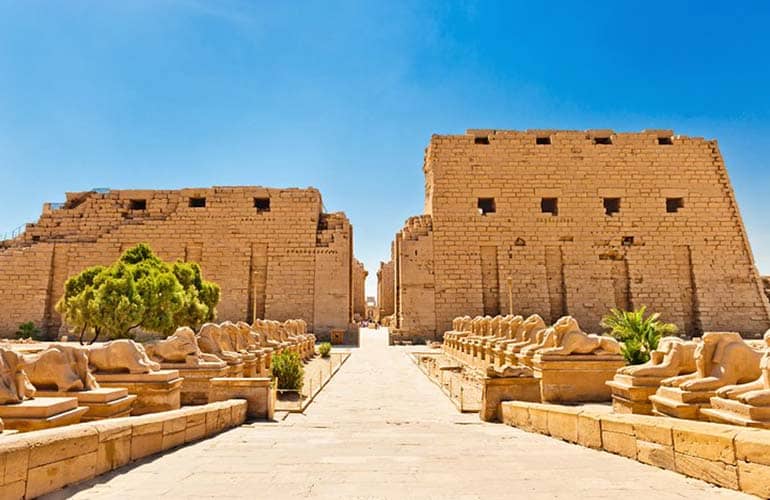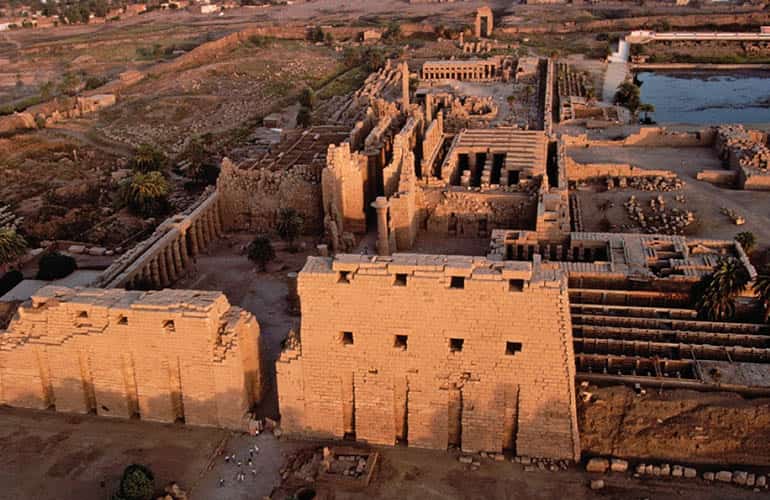Karnak Temple Facts:

The Karnak temple is located in Luxor, the capital of old Egypt for more than 1500 years, coinciding with the period of splendor of the new pharaohs of the New Empire. In ancient times it was not called Karnak, but the northern House of god Amun, as the Temple of Luxor was the southern House of god Amun. Luxor means City of Palaces and in ancient times this city was known as Thebes.
The complex is divided into three buildings: Montu Temple Enclosure, Amun Temple Enclosure with Temple of Khonsu, and Mut Temple Enclosure. Each one is surrounded by a wall, which delimits it. The largest enclosure, that of Amun, consists of several pylons, alternated with open courtyards, where there are statues and obelisks. The great hypostyle hall was closed, although the sun entered through small openings at the top. At the crossroads between the two axes of the enclosure, you can see the obelisks erected by the pharaohs of the 18th century.
Temple of Amun Re
The large trapeze-shaped Amun enclosure is in the center of the vast area occupied by the Karnak temples. The buildings in the enclosure follow a double axis, east-west, and north-south. In addition, around these two axes and the main temple a group of minor temples, chapels, and a sacred lake are added.
The first pylon is preceded by a quay that connects the Amun enclosure with the banks of the Nile. The present form proceeds the restorations of the Twenty-fifth Dynasty of Egypt, with an avenue of ram-headed sphinxes with the name of Pinedjem I. The courtyard that opens next has a triple chapel boat of Seti I, dedicated to Amun, Mut, and Khonsu. A temple for the sacred boats of Ramesses III appears on the south side of the courtyard. The second pylon is almost certainly the work of Horemheb and is preceded by colossal statues of Ramesses II. Then appears the hypostyle room which is the most impressive area of this complex, with columns in the form of papyrus. The third pylon was built by Amenhotep III, although the portico was decorated by Seti I and Ramesses II. In this pylon, we find a structure for the celebration of the festival Thirst of Senusret I.
In addition, there were four obelisks to mark the entrance, of Thutmose I and Thutmose III, although today only one remains standing. Between the pylons, the Fourth Dynasty of Egypt and the Fifth Dynasty of Egypt the oldest part of the temple is still preserved today. The central courtyard behind the sixth pylon has a room in the temple known as the “botanical garden”, for its depictions of plants, birds and exotic animals.
The other axis towards the south was extended with four more pylons. The 7th pylon is known as the “sealed courtyard”, and it was there that numerous statues were found in a secret deposit at the beginning of this century. The 9th and 10th pylons are due to Horemheb. Many “Talatat” or building blocks from Akhenaten were reused for these pylons.

The Temple of Montu at Karnak
This compound is the smallest of the three. It contains the main temple dedicated to the god Montu, some secondary structures dedicated to the god Khepri (Kheper) or the goddess Maat and a sacred lake. The main temple is preceded by a pier that connects to the Nile River and an avenue of sphinxes with human heads that leads to the temple from the north.
The Temple of Mut
In the southern sector, we can find the temple of Mut, which is surrounded by a lake in the shape of a crescent, and some secondary structures such as the temple of Khonsu, of the Eighteenth Dynasty of Egypt, and a temple of Ramesses III (Medinet Habu). The temple of Mut was built by Amenhotep III, although Ramesses III himself ordered the construction of a subsidiary temple for the sacred boats that went out in procession or for the other divine boats that entered the enclosure of the Lady of Thebes.
The key difference between Karnak temple and most other temples and sites in Egypt is the length of time during which it was developed and used.
The construction of temples began in the Middle Kingdom and continued until the Ptolemaic period. Approximately thirty pharaohs contributed to the buildings, allowing it to achieve size, complexity, and diversity not seen elsewhere. Few of Karnak’s individual features are unique, but the size and number of features are overwhelming. The deities represented rank among some of the earliest worshipped ones much later in the history of ancient Egyptian culture. Although destroyed, it also contained an early temple built by Amenhotep IV (Akhenaton), the pharaoh who later held a monotheistic religion nearby established that it led him to spend his court and religious center far from Thebes. It also contains evidence of adaptations, with buildings of the ancient Egyptians by later cultures for their religious purposes.
The best way to discover the Temple of Karnak is with an expert guide who will show you the most hidden and interesting spots while telling you the most peculiar and surprising stories. You can book the visit to Karnak combined with that of the Temple of Luxor with Cleopatra Egypt Tours.






